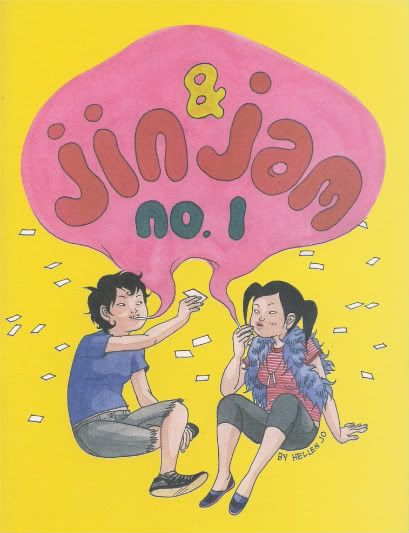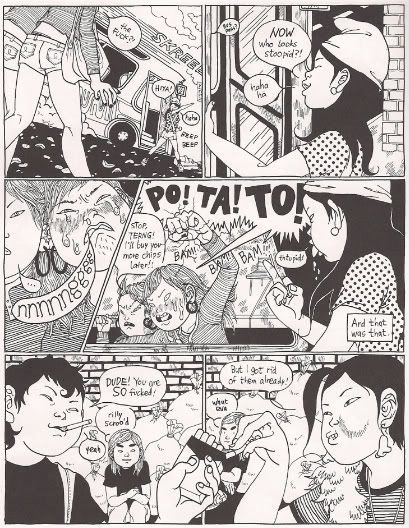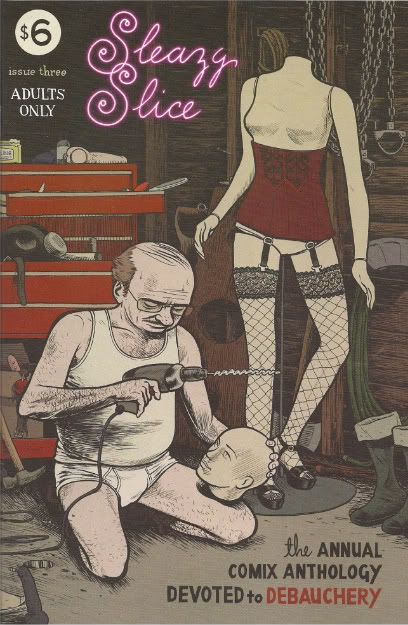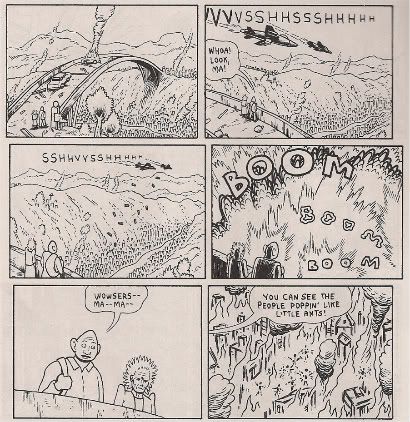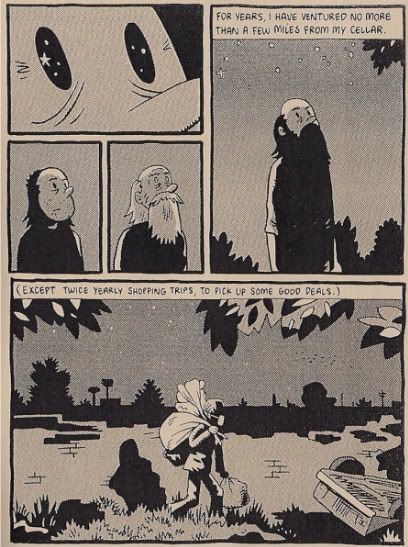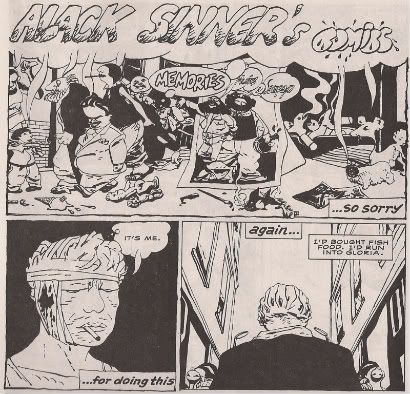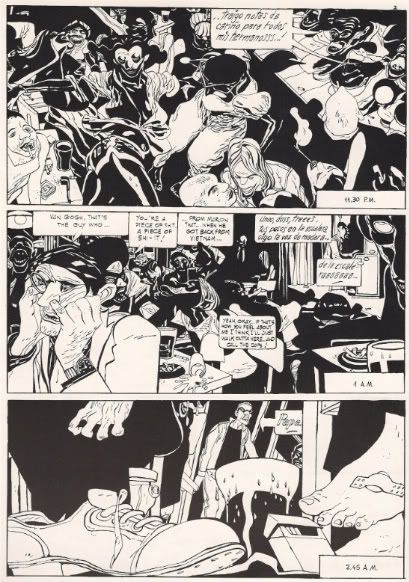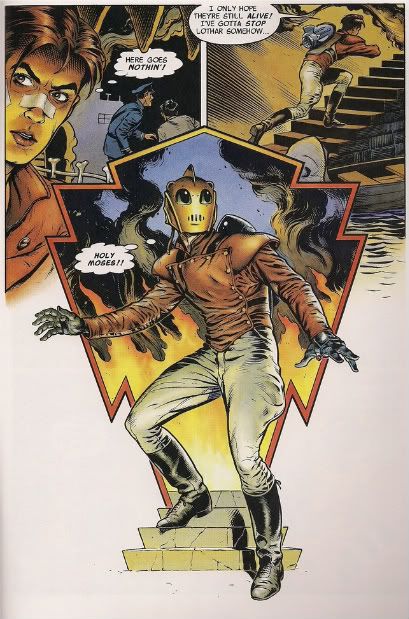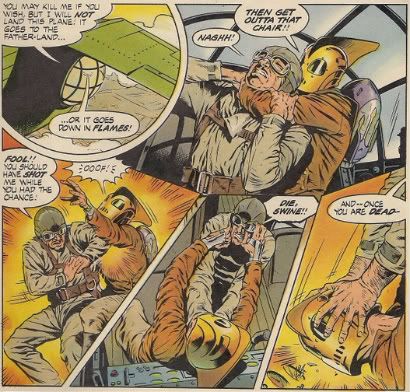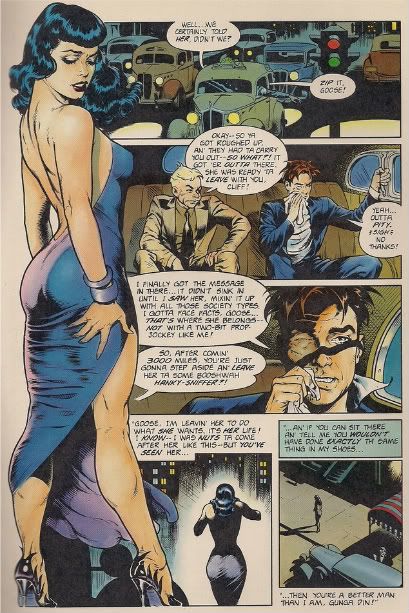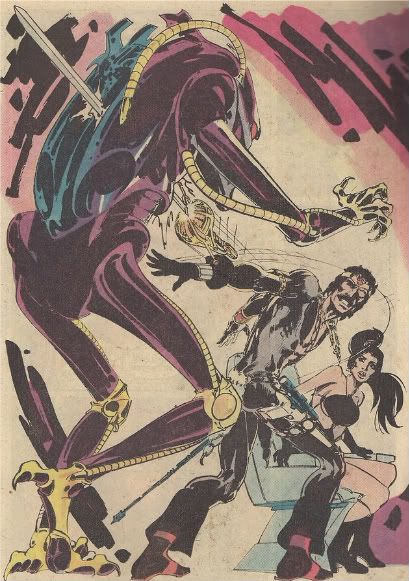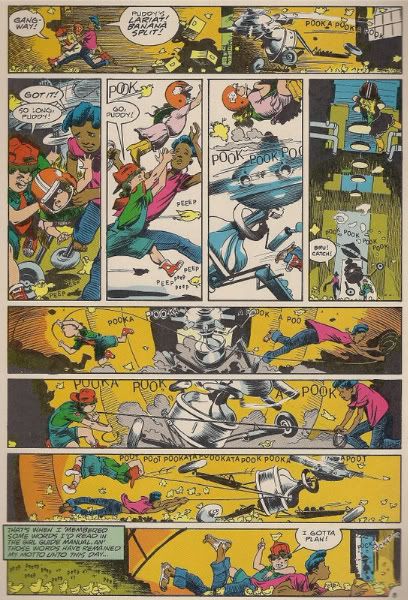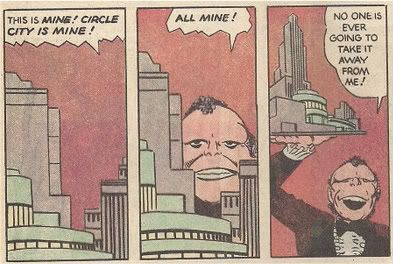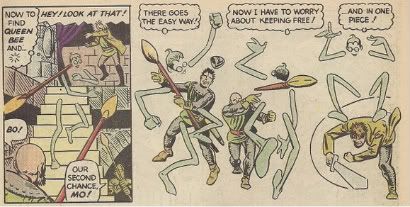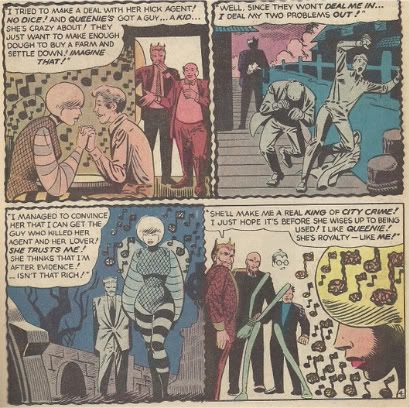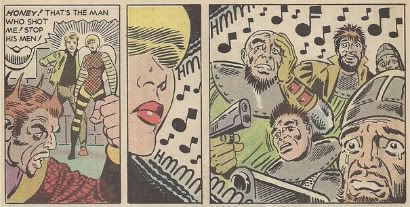WARNING: Contains French.
LAST WEEK'S REVIEWS:
Jin & Jam #1, Sleazy Slice #3 and Rumbling Chapter Two (all pamphlets, all the time)
Yep.
*You might not know it, but we're coming up on an anniversary soon. A five-year celebration. Not right know, not for a few months, but soon. And there's a lot of stuff tied up in it - dreams, capitalism, culture. Comics too. Lots of comics; more than anyone wanted to read at the time.
Remember DC/Humanoids? Yeah, it was that long ago.
I refer, of course, to the 2004-05 publishing arrangement between DC Comics and Humanoids Publishing, the American branch of Les Humanoïdes Associés, the famous French publisher of Métal Hurlant and other things that could appeal to DC's readers. It didn't last long, but holy shit did those softcover books rush the shelves, multiple French albums in nearly every one, thousands of pages of European comics suddenly available.
I don't think folks kept up with many of them. There wasn't much in the way of advertising, or even organization; stuff just kept spilling out, until it stopped. Humanoids is teamed with Devil's Due these days, and they're playing it much safer: a few pamphlet-format series at a time, 'name' artists only. It's so easy to keep track of. You'd have to be a fool to take on all that DC stuff.
Well you know what? Wednesday is April Fool's Day, and I'm in a very foolish mood. So's Tucker Stone; we share space on two websites, and we talk about foolish things sometimes.
And that's totally what's happened here, and here's what we're gonna do, 'cause we liked the DC/Humanoids days, we liked that potential, and we don't think anyone totally dove in: starting sometime this Wednesday, and continuing for two weeks and change, Tucker and I are going to somehow hit every book released by DC/Humanoids.
It's a team-up, an old-fashioned joint effort, a study of a bountiful calamity that could only be called... Désastre Hurlant!!
It'll be so much fun, at least until I blow the schedule. You might get a full review on Tucker's site one day. You might get a bunch of small reviews on this site another day. On another day, on anothe site (like, um, Sunday at The Savage Critics), you might get a conversation between the two of us. It'll be easy to follow, back-and-forth. All we're planning to skip is the pre-DC Humanoids stuff -- sorry fans of Negative Exposure, one day your ship will come in! -- and any of the comic book-type stuff, which was mostly stuff later collected into trades and I Am Legion, which Devil's Due is publishing right now anyway. Or Lucha Libre, which was with Image. And I'm probably going to fool with the format once or twice. This is a lot of equivocation, and I should stop.
Why are we doing this? I have no idea. But we are! And there's a lot of meat in here! Some books are classics, others are total crap! Shit, a bunch of these series never even finished! There's ideals at play! Misconceptions! Headaches! What japes! BE THERE!!
*It won't just be BD for me for two weeks, though. I do plan on getting through at least one fresh U.S. release per week, and obviously keeping up the weekly feature you're about to read -
THIS WEEK IN COMICS!
Supermen! The First Wave of Comic Book Heroes 1936-1941: And what's more all-American than a 192-page collection of 20 Golden Age superhero stories, all of them pre-WWII, as far as U.S. involvement goes. By the thesis of project mastermind Greg Sadowski, those were the wild days, when the genre swang and spat in every direction, violent and unconsidered, and red with desire to rip new, fast entertainment from on-the-sleeve media influence and rollicking no-rules storytelling. A compelling case; inspiring, even. My review is here. Published by Fantagraphics at $24.99; nice sample story here, slideshow preview here.
Dungeon Zenith Vol. 3: Back in Style: Ah, speaking of France! Plenty of people have looking forward to this one, NBM's latest 96-page, $12.95 softcover collection of the Joann Sfar/Lewis Trondheim comedy-fantasy-adventure creation; this time we get the (as of now) final two volumes of the 'present' iteration of the series -- not to be confused with the 'future' of Dungeon Twilight and the 'past' of Dungeon: The Early Years -- which also see Trondheim hand the art duties over to one 'Boulet' (Gilles Roussel). Previews en français can be accessed here and here.
Seaguy: The Slaves of Mickey Eye #1 (of 3): Speaking of a long time coming, here's a big 40 pages of anticipated stuff for $3.99. Actually, I'm more cautiously optimistic about this than anything; the original 2004 Seaguy miniseries is tied with The Filth for the valuable title of 'my favorite Grant Morrison-written work of the 21st century thus far,' but unlike that longer, dirtier Vertigo work, Seaguy is absolutely a product of its time for me. Morrison was just off his contentious run on New X-Men at the time; he'd severed ties with Marvel, which already seemed to be tripping over itself to undo or nullify some of the more substantive changes Morrison had included in his future-focused run ("Wolverine. You can probably stop doing that now."), and had sort of holed up in Vertigo to play with new ideas.
Seaguy was the first result, a bracingly downbeat superhero story spiked with absurd humor and broadly devoted to demonstrating how a small man might only glimpse the grand corruptions of the world before becoming absorbed by lulling comfort culture. Applied specifically to superheroes, it became a cruel parody of rote genre thrill rides and would-be mythic tropes, climaxing with its hero getting all the good developments revamped straight out of him, and his concept reset to the corporate-pleasing status quo. Our only prayer is that the little things he accomplished while he was interested might spread out one day to make the society better, possibly without his knowing what was done anymore. It was revealing stuff, maybe the most conflicted expression of Morrison's professional relationship with the superhero genre. It got so when people started asking me what Seaguy was 'about' -- somehow, its mix of metaphor and comedic non sequitur won it a grossly overblown reputation for opacity -- I'd tell them it was about writing New X-Men. Which is probably not entirely accurate, but it does get to the heart of things.
In all candor, it took me a while to realize Morrison wasn't joking when he said he wanted Seaguy to be a trilogy; the promise of further adventures in the midst of the original's wonderfully ambiguous ending seemed like the perfect final joke, since what's a worse hell for a superhero than to keep on living forever, always reset to some dictated 'optimal' state? Actually having a sequel strikes me as possibly gilding the lily, particularly since Morrison's spent part of the half-decade's interim whipping up a massive exploration of arguably the same themes (Seven Soldiers). Will Seaguy remain a forum where Morrison's anxiety can run rampant? Eh, at least the jokes should be sharp, and Cameron Stewart's always a pleasure. The preview below this interview is pretty great too, so here's hoping.
Still I Rise: A Cartoon History of African Americans: This is an updated edition of a 1997 book from writers Roland & Taneshia Nash Laird and artist Elihu "Adofo" Bey, starting their story in 1618 and moving right up to the present day over 240 pages. I don't know anything else about it, but I'm sure it's worth flipping through at least. From Sterling; $14.95.
Alan Moore: Comics as Performance, Fiction as Scalpel: Being a new volume of Magus scholarship from Milan-based author Annalisa Di Liddo and the University Press of Mississippi, vowing to explore how Moore "employs the comics form to dissect the literary canon, the tradition of comics, contemporary society, and our understanding of history," while pinpointing his crucial thematic threads: "the subversion of genre and pulp fiction, the interrogation of superhero tropes, the manipulation of space and time, the uses of magic and mythology, the instability of gender and ethnic identity, and the accumulation of imagery to create satire that comments on politics and art history." Coverage of Skizz is promised. It's a 192 (or so) page softcover, priced at $22.00.
Boody. The Bizarre Comics of Boody Rogers: Nothing like a well-placed bit of punctuation to catch the eye. One day, everyone featured in Dan Nadel's 2006 oddball comics survey Art Out of Time: Unknown Comics Visionaries 1900-1969 will have a book of their own, save for the folks who had their entire surviving catalog presented in Art Out of Time itself. We're now another step closer, thanks to Fantagraphics and Craig Yoe, and their bottomless desire to bring 144 pages of work by the deranged Golden Age funnybook artist into this world as a $19.99 showcase; do note, however, that the 20 Boody pages from Art Out of Time are repeated. With Sparky Watts, Dudley and all your favorites, including a deeply, deeply odd short (which I first encountered in RAW Vol. 2 No. 2) concerning rustic gal Babe's journey to the top of Mystery Mountain, whereupon centaurs mount kidnapped women and ride them around for sport. There's a dozen or so references to the glue factory. You will doubt your sanity. Sample story here, preview slideshow here.
Ho! The Morally Questionable Cartoons of Ivan Brunetti: Also in Fantagraphics collections this week, here's a 112-page, $19.99, Patton Oswalt-introduced omnibus compilation of Ivan Brunetti's excellent, take-no-prisoners gag panels, culled from the books Hee! and Haw!, and various anthologies. Here's what you're in for; page 10 is a personal favorite of mine. Have a slideshow.
Gankutsuou: The Count of Monte Cristo Vol. 2 (of 3): A 208-page continuation of artist Mahiro Maeda's manga adaptation of the television anime he directed himself, from the Dumas classic. It's not often you see this much multimedia involvement by one guy, and Maeda has the added benefit of a minimalist, eccentric comic style that occasionally swings for mega-splash power-of-the-gods-and-machines psychosis in the manner of Philippe Druillet, sort of. I couldn't call it great, but I sure wish more anime tie-in manga would put in this much effort.
The Melancholy of Haruhi Suzumiya: This, on the other hand, isn't a manga at all; it's an $8.99 Little, Brown release of Nagaru Tanigawa's 2003 light novel (illustrated by Noizi Ito), the spark that ignited the still-strong Haruhi inferno. Many, many sequels followed, along with a much-adored 13 episode television anime and a billion other things. I'm not gonna spend any time explaining Haruhi - if you know it, you really know it, and if you're just curious it's probably better you go in not knowing anything, although your final level of enjoyment may well depend on how much of your brain matter is currently saturated with anime otaku fandom bullshit. At least that's how it went with the show, which I found to be thoughtful about its genre and fairly smart and comfortably above average as far as anime about a guy surrounded by pretty girls go, but not terribly relevatory, or even particularly deep. Hey, don't mind me, tomorrow I'm gonna drop my money on Shigurui: Death Frenzy; I knew the dude who directed Texhnolyze would find work again!
The Boys #29: Man, you know I'm all right with this series, it's a solid little comic month in and month out, but I think we're all ready for the final issue of this X-Men parody storyline about now. So here it is; hope it builds to something. Preview. I hear you can also get issue #1 of Preacher for $1.00 this week; note that those new 350-page hardcovers are due to start in June.
glamourpuss #6: Dave Sim, moving on.
Universal War One - Revelations #1 (of 3): Of course, while DC/Humanoids might be firmly in the past, let's not forget that Marvel's association with French publisher Soleil is still putting along, translating popular genre albums to English and the pamphlet format. This new 'miniseries' is actually just the final three volumes of Denis Bajram's 1998-2006 time-travel-in-outer-space suspense series, since Marvel (I suppose) felt it'd be worthwhile to break things in half. If it's even this far along, that's probably an ok sign, right?
Captain America Comics 70th Anniversary Special: And finally, if somehow the tome on top of this list didn't give you enough '40s ferocity to keep you regular, here's a $3.99 ode to the comic that Sadowski takes as symbolic of the domestication of the superhero concept, put in the service of a national struggle and made icons of a particular heroism over iterations of a plural good. Simon & Kirby are present, although Marvel also has a new story by James Robinson & Marcos Martin (w' colorist Javier Rodriguez) on tap. Are you ready to be stirred? Don't ask if it'll shake ya.
